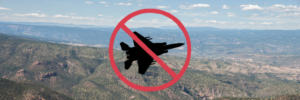
FOR IMMEDIATE RELEASE
September 10, 2024
Contacts:
Allyson Siwik, Gila Conservation Coalition, allysonsiwik@gmail.com, 575-590-7619
Todd Schulke, Center for Biological Diversity, tschulke@biologicaldiversity.org, 575-574-5962
Patrice Mutchnick, Heart of the Gila, heartofthegila@gmail.com, 575-574-8342
Luke Koenig, New Mexico Wild, luke@nmwild.org, 443-676-3200
Kim Vacariu, Peaceful Chiricahua Skies, kimvac@vtc.net, 520-390-3969
David Becker, Bird Alliance of Southwestern New Mexico, dhebecker@yahoo.com, 971-207-7216
Conservation Groups Oppose Air Force Proposal for Low Elevation and Supersonic Airspace Over Rural Communities and Tribal Lands in Southern Arizona and Southwest New Mexico
This week the Air Force will host four public hearings on the draft Environmental Impact Statement for expanding its airspace for its Arizona missions. Conservation organizations in New Mexico and Arizona are expressing their serious concerns with its proposal to authorize low-elevation fighter jet maneuvers as low as 100 feet above ground level (AGL) and supersonic flights as low as 5,000 feet AGL in southern Arizona and southwest New Mexico.
“The Air Force’s proposal will cause extreme noise and sonic booms above rural communities and tribal and public lands, including some of the Southwest’s most fragile sky-island ecosystems, and beloved wilderness areas and national monuments. The Air Force has not justified why it can’t continue to conduct this high-risk training at the Barry M. Goldwater Range,” said Allyson Siwik, executive director of the Gila Conservation Coalition and partner in Peaceful Gila Skies.
Conservation organizations will tell the Air Force that expanding military combat training over rural communities and tribal and public lands is not acceptable. The Air Force should restrict its lower elevation and supersonic flights, and other combat training, such as dropping chaff and flares, to the Barry M. Goldwater Range where it’s already happening. The Air Force must not shift the burden of risk to rural and tribal communities in southern AZ and SWNM.
“The DEIS is designed to deceive the public, inflating the actual need for the proposed action by including thousands of A10 Warthog flights in the analysis even though they know the A10 will be phased out soon,” said Todd Schulke, co-founder of the Center for Biological Diversity and partner in Peaceful Gila Skies. “The Air Force needs to pick back up the dropped alternative looking at doing the low elevation and supersonic combat training at Barry M. Goldwater Range where they are set up for the risk,” added Schulke.
“The communities in our corner of Southwest New Mexico depend on public lands for the foundation of our outdoor economy. Protecting these places from expanded military training protects our livelihoods and our culture. We oppose this plan because it threatens our way of life and our ability to preserve these wild places for all Americans,” said Patrice Mutchnick, executive director of Heart of the Gila and partner in Peaceful Gila Skies.
“Designated Wilderness is only about 2 percent of the land in New Mexico. And it’s within those boundaries that we find our last remaining, irreplaceable bastions of true quietude,” said Luke Koenig, Gila Grassroots Organizer with New Mexico Wild and partner in Peaceful Gila Skies. “What’s more, the legacy of Wilderness protections is something we take particular pride in here in southwest New Mexico, where the world’s first wilderness—the Gila Wilderness—was designated one century ago. It is unthinkable that the US Air Force thinks that the airspace above the Gila Wilderness is an appropriate place to expand military combat training and dramatically lower the floor for sonic booms, especially considering that the Barry M Goldwater Range—a designated military training zone—is already at their disposal.”
“The whole process surrounding this DEIS is suspect,” says Karen Fasimpaur, a volunteer with Peaceful Chiricahua Skies, a coalition informing the public about this proposal. “The Air Force has declined to hold public hearings in some of the rural and tribal locations most affected by the proposal. They have declined to share information, like scoping comments, that are normally public information. They have declined to respond to FOIAs. We wonder what they are trying to hide.”
“Every year, tens of thousands of people visit the public lands that would be affected by the Air Force’s intensification of combat flight training to observe or photograph birds,” said Dawn Smith, Conservation Chair for the Bird Alliance of Southwestern New Mexico. “The louder, lower-elevation, and more frequent noise from military jets, many flying at supersonic speeds, is an unacceptable intrusion which will have a negative effect on the natural lives of the birds in the Chiricahua, Gila, and other affected areas. Birders depend on quiet, natural noisescapes to be able to watch birds. More than doubling the number of flights over the Chiricahua Mountains will irreparably harm the area’s attraction as an important, species-rich birding area, and lowering the floor for supersonic flights over the Gila likewise risks harming birds and the opportunities birders enjoy for quiet, natural recreation, with secondary harm to the local economy.”
More information is available at:
Peaceful Gila Skies – https://peacefulgilaskies.com/
Peaceful Chiricahua Skies – https://peacefulchiricahuaskies.com/

